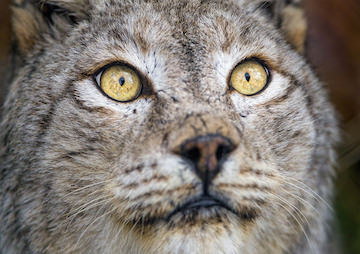Eye Shape Tells Whether an Animal Is Predator or Prey
Scientists have determined that the shape of an animal’s eye has everything to do with its adaptation to a particular place on the food chain. A lynx on the lookout for prey. (Tambako the Jaguar / CC BY-ND 2.0)
A lynx on the lookout for prey. (Tambako the Jaguar / CC BY-ND 2.0)
Scientists at the University of California, Berkeley, and Durham University in England have determined that the shape of an animal’s eye has everything to do with its adaptation to a particular place on the food chain.
Because keeping watch on the surrounding area is so important for a grazing animal, its pupils can rotate 50 degrees to remain horizontal.
The Guardian reports:
“The first key visual requirement for these animals is to detect approaching predators, which usually come from the ground, so they need to see panoramically on the ground with minimal blind spots,” said Professor [Martin] Banks [of Berkeley]. “The second critical requirement is that once they do detect a predator, they need to see where they are running. They have to see well enough out of the corner of their eye to run quickly and jump over things.”
The two scientists and their colleagues report in the journal Science Advances that they looked at the eyes of 214 closely-studied animals, all terrestrial vertebrates. These included Australian snakes, every species from the cat and dog families as well as hyenas and mongooses, and domestic grazing animals as well as tapirs and rhinoceroses. The challenge was to see if they could predict a relationship between an animal’s ecological niche and the shape formed by the pupil in its eye.
They found a pattern. The smaller ambush predators – those little creatures that lie in wait for their lunch – are more likely to have pupils that narrow vertically. Hunters that prowl by day or night need to make the most use of available evening light yet exclude the glare of the sun, which is why the eyes must narrow dramatically. The mouse-hunting domestic cat can change the area of its pupil gaze 135-fold and the insectivorous gecko 300-fold. Round-eyed humans – that is, with circular pupils – can reduce them 15-fold.
But humans walk tall. So do lions and tigers, and they too have round eyes and circular pupils. The big cats are “active foragers”: they hunt down their prey. The researchers included 65 ambush predators with eyes in the fronts of their heads for this study. Of these, 44 had vertical pupils and 82% had shoulder heights less than 42 cms or 16.5 inches. So the reasoning is that binocular vision and vertical slit pupils together make it easier for small animals to pounce, by using the difference between close focus on the innocent dinner and the out-of-focus or blur beyond and before it, to judge the distance precisely.
Read more here.
— Posted by Alexander Reed Kelly.
Your support is crucial…With an uncertain future and a new administration casting doubt on press freedoms, the danger is clear: The truth is at risk.
Now is the time to give. Your tax-deductible support allows us to dig deeper, delivering fearless investigative reporting and analysis that exposes what’s really happening — without compromise.
Stand with our courageous journalists. Donate today to protect a free press, uphold democracy and unearth untold stories.






You need to be a supporter to comment.
There are currently no responses to this article.
Be the first to respond.